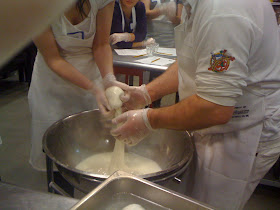Strawberries and rhubarb mark the beginning of fruit-pie making season. They are the first fruits that come to season into the spring, an absolutely my favorite type of pie to prepare. The sweetness of fresh spring strawberries is just so perfect with the tangy, tart rhubarb. Rhubarb is a strange fruit, which kind of looks like pink celery. If you have never worked with it before, you might wonder, wait, do I really want to put this in my pie? But when it cooks in the oven with the strawberries, it assumes a lovely tart flavor that pairs perfectly. I do not recommend making an all strawberry pie - too sweet. But the strawberry-rhubarb combo is my favorite, and for my kitchen, it makes the beginning of the spring fruit season.
To make this pie, I used the exact same crust for apple pie, with my own strawberry-rhubarb filling.
Sasha's Strawberry Rhubarb Pie
2 1/4 cups flour
big pinch of Kosher salt (not, this is the grainy salt; never bake with iodized salt!)
pinch of sugar
2 sticks of cold butter
1/4 cup of ice water, plus a but more if needed (this time I used about 2 T additional ice water)
21/2 cups of fresh strawberries, hulled and sliced
2 1/2 cups of rhubarb, sliced into 1/2 inch pieces
3/4 cups of sugar (you could probably even get away with 1/2 a cup if you are concerned about sugar intake)
1 T lemon juice
1/2 tsp cinnamon
3 T cornstarch
2 egg yolks
Roll out one of the balls on a well floured surface, rotating after each roll or two so it does not stick to your surface. Roll to 1/4 of an inch thick and place in the pie dish, before trimming the edges with a pastry scissor. Using a pyrex pie dish
Combine the ingredients for the strawberry rhubarb mixture. Add most of this to the pie - about four and a half cups total. Be sure not to heap the fruit, as tempting as it may be to use every last drop of the fruit mixture. I recommend using the freshest, local organic/farmer's market strawberries and rhubarb you can get your hands on as it will make your pie that much better. I also use organic butter in the crust.
Roll out the second ball of dough the same way and cut to form a lattice. I glazed the top of the pie using two egg yolks and sprinkled some granulated sugar on top. Bake the pie at 425 covered with foil for 30 minutes. Then, reduce the heat to 350 and remove the foil baking for another 30-45 minutes (my oven required about 35). The pie is done when it is tender when poked with a knife.


























